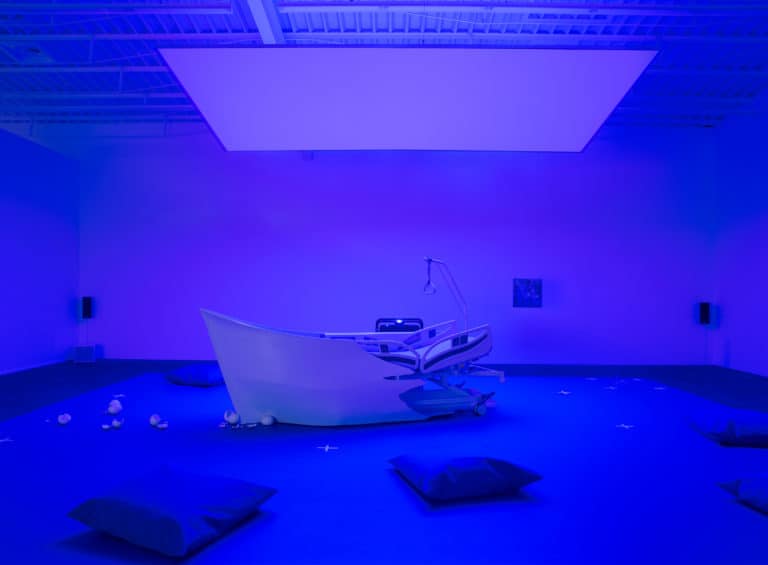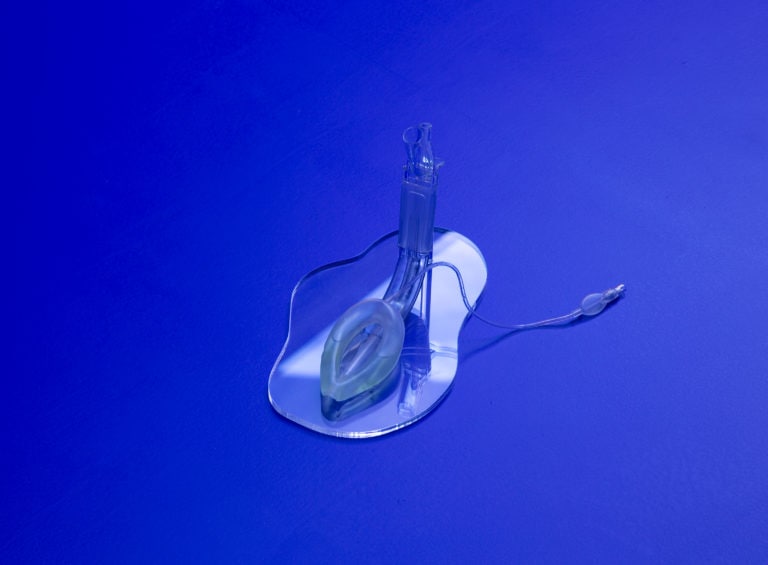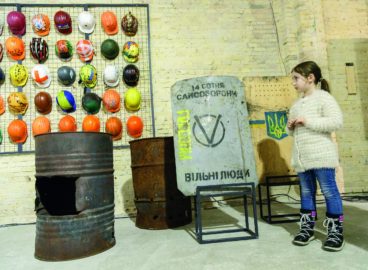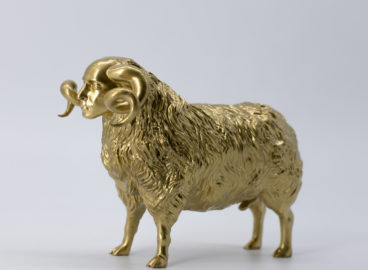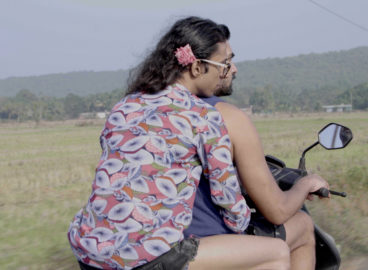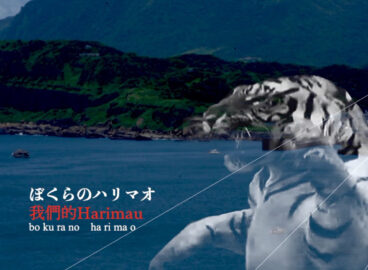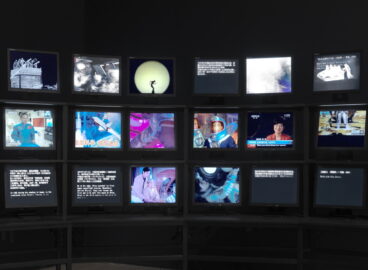This conversation between filmmaker and artist Thuy-Han Nguyen-Chi and C-MAP Asia Fellow Wong Binghao took place over the course of a year, from November 2021 to November 2022. The text is accompanied by a two-week screening of Nguyen-Chi’s recent film Into The Violet Belly (2022), film stills and installation images, and a GIF by designer Ghazaal Vojdani that responds to the issues and inspirations raised in the conversation.
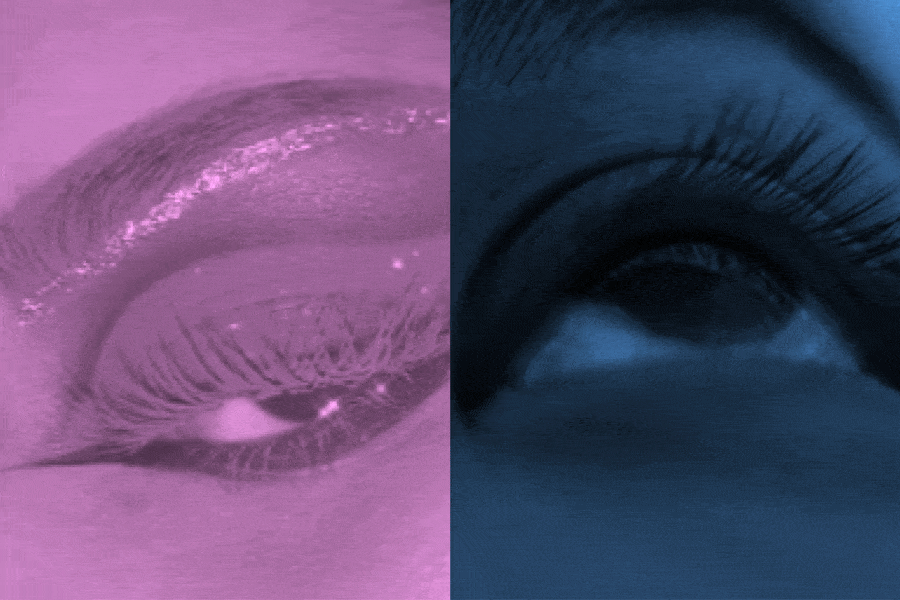
November 2021
Thuy-Han Nguyen-Chi: I thought we could start with something personal. One of the points of connection I have observed throughout our conversations over the last months is our relationship to our mothers.
Wong Binghao: Yes, we just realized that last week was both of our mothers’ birthdays.
THNC: Yes, that’s such a sweet coincidence.
WBH: Could you tell me more about the new video that you’re making in collaboration with your mother about her life experiences, among other things?
THNC: I actually just finished the script, but the project is still in its embryonic stage. So I can’t share anything concrete yet, but I can talk about the various conditions that may have brought this project, which is part of a trilogy I began working on in 2016, into existence. The In/Extinguishable Fire (2019), the second part of the trilogy, opens with this image: An unidentifiable figure stands alone at the beach at night in Hội An, Vietnam, illuminating the waves with a torch in search of something unknown to both themself and the viewer. I decided to shoot this opening scene at that particular location after an encounter in December eight years ago. On that hot and humid afternoon, I was sitting with B—an essayist, political activist, and philosophy professor—in his office, listening to him speak about his youth and adulthood, the things that moved and shaped him, from the period of French colonialism to American imperialism to present-day Vietnam. He told me he began speaking French in elementary school, and how deeply he was influenced by French culture and literature. He told me how his thoughts on freedom [tư tưởng về tự do], paradoxically, were nurtured by the very education that was meant to colonize him. He told me that he was a member of the anti-French resistance youth group in the 1950s and once attempted to burn down a French school. He organized Central Highland tribes into guerrilla units to fight the French. He told me about the first time he saw the corpse of a friend. I was shaken to the core when I left his office after three hours of conversation. I was so moved by his presence, his actions, his experiences, and the idea of a colonizing tool being transformed into a tool of liberation. Later that week, I went for a night walk with him on the beach in Hội An. We walked in silence for a long time until we stopped to observe the movements of the dark waves. After a while, he said something like, “Whenever I look at the ocean, I think of all the corpses lying on the ocean bed. I was not brave enough to flee this country. They died and I survived.”
A few years later, again in December, I was sitting next to my mother in the darkness of the cinema, when I witnessed her being overwhelmed by a feeling of nausea as rays of light entered her eyes. She was looking at an image of a spaceship moving through a wormhole, when she told me, “It reminds me so much of being on a boat when I escaped Vietnam.” In the film being screened, the protagonist goes on an interplanetary odyssey in search of a habitable planet necessitated by an impending apocalypse on Earth. In that moment, the collision between memory and cinema created some kind of wormhole through which her present mind/body traveled. I realized that a work of science fiction and speculative futurism has the potential to activate archives experienced as somatized trauma—memories of the future.
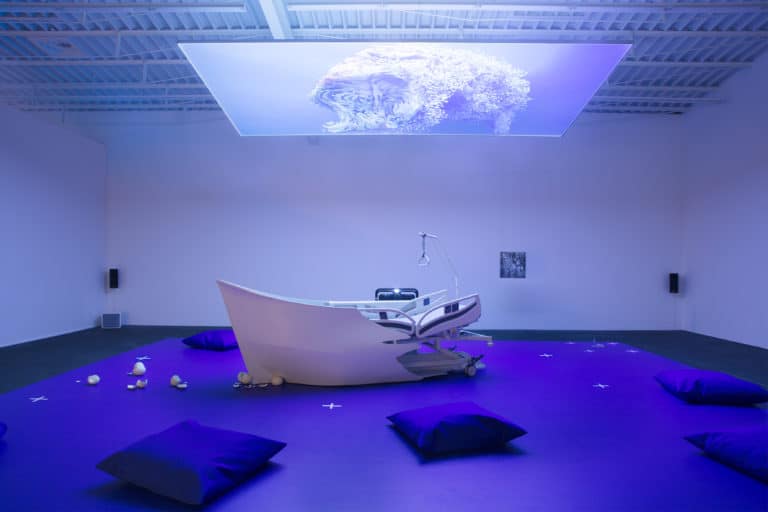
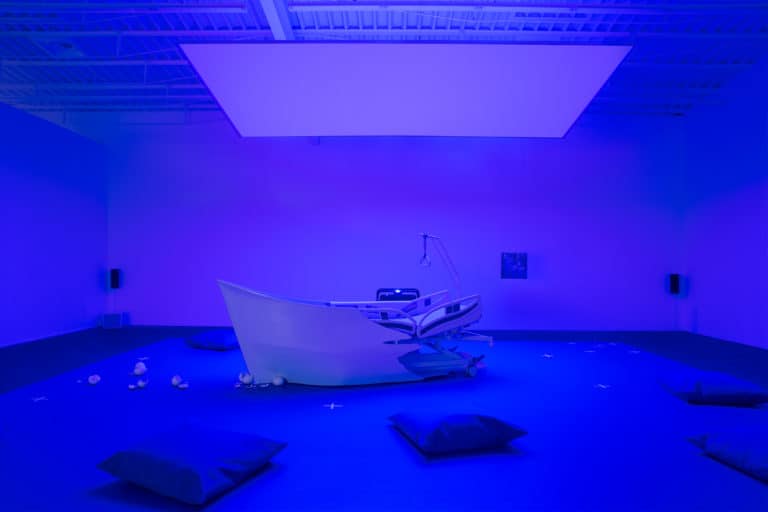
Speaking of memories, a moving image that has haunted me since I was a teenager is the image of a jump, although—or because—it is an image I have never seen but have only imagined. After stepping onto a fishing boat in Long Xuyên in the spring of 1979, my mother spent three days floating across the South China Sea. She was without food for three days because the mung bean cubes and citrus fruits she had brought along were stolen. Three days of talking to the captain to keep him awake. Three days of taking care of those who were feeling sick. Three days of looking at the celestial sphere every night with a sense of wonder, with a sense of uncertainty. Three days of oscillating between possible freedom and possible death. On the third day, they were accompanied by a pod of dolphins while approaching Songkhla, Thailand. On the third day, death possibly equaled freedom, my mother—who, back then, was not able to swim—decided to jump into the ocean. I won’t elaborate on the circumstances here, but you will understand once you see the film in a few months.
The idea of freedom really intrigues me because of how B uses the term within the context of anti-colonial resistance and because of how my mother uses it when she recounts her escape, specifically in the moment she jumped, surrendering to death. I’m not interested in the liberal discourse of freedom1Describing the premise of a global power perceiving its self-interest secured by granting to another the gift of freedom, Mimi Thi Nguyen asks the following: “How then do we parse the seeming paradox in which U.S. military interventions are described through beneficence and defense, and at the same time demand occupations and dislocations of racial, colonial others in the name of the human, through invocations of peace, protection, rights, democracy, freedom, and security?… What then does it mean for a racial, colonial other to ‘finally’ possess freedom? How can it be that the possibility of ‘owning’ freedom is worth everything and nothing?” See Mimi Thi Nguyen, The Gift of Freedom: War, Debt, and Other Refugee Passages (Durham, NC: Duke University Press, 2012), xii, 17–18.—I’m searching for a different conceptualization of freedom, one that includes a recasting of freedom in refugitude2“Refugitude” is a term advanced by Khatharya Um: “Whereas the term ‘refugee’ has been made synonymous with needs, refugitude rescues it from reductionist pejorative connotations with equal attention to hope and futurity. It replaces reductionism with attention to complexity of refugee lives, and binaries with juxtapositions and interstices as dynamic sites of negotiation and creation.” “Critical Vocabularies,” Critical Refugee Studies, https://criticalrefugeestudies.com/resources/critical-vocabularies., but I haven’t quite figured it out yet. A few years ago, I came across this set of questions in Hélène Cixous’s essay “We Who Are Free, Are We Free?”3Hélène Cixous, “We Who Are Free, Are We Free?,” trans. Chris Miller, Critical Inquiry 19, no. 2 (Winter 1993): 201–19, http://www.jstor.org/stable/1343873. which really resonated with me: “What am I in relation to freedom?4Hélène Cixous’s original question is “What am I in relation to liberty?” Ibid., 202. What are we? What are you? Am I free? Have I ever been free? Have we? Have you? Where is freedom to be found, where does liberty find refuge when it is under threat?”5Ibid., 201–19. And I like to think about these questions in relation to this particular imaginary that Angela Davis addressed during a conversation with Toni Morrison: “How do we think about freedom? It is about the deeply historical character of our own imaginings of what it means to be free… Because I think we won’t ever reach a point where we can say, ‘We are free.’ It seems that in the very process of struggling for, reflecting on, and writing about freedom, we constantly challenge the framework, within which we develop that imaginary of freedom.”6Angela Davis, “Angela Davis and Toni Morrison Literacy, Libraries and Liberation,” posted by Daryl Banks, April 21, 2022, YouTube video, 1:44:59, https://www.youtube.com/watch?v=zLR_TcGHzRU.—the imaginary of freedom is continuously metamorphosing as it moves through time and space! I wonder what this imaginary meant for our grandmothers and mothers, what it means for you and me now, what it will mean for generations to come, and how these imaginaries, conditioned by various personal, political, cultural, historical conditions and contexts, generate different meanings when you reflect on them in relation to each other.
I’m really fascinated by our imaginaries of freedom and of death, by the potential entanglement between these imaginaries and how they shape us. On another level, I’m also preoccupied with the death/birth of a perception, an imaginary, a narrative, an image of a self; and experimenting with memory, imagination, performance, and moving images is my attempt to think and live through these questions.
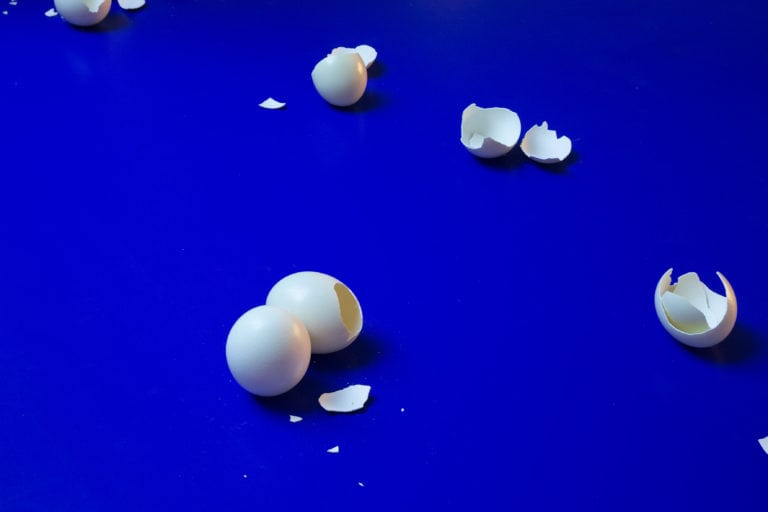
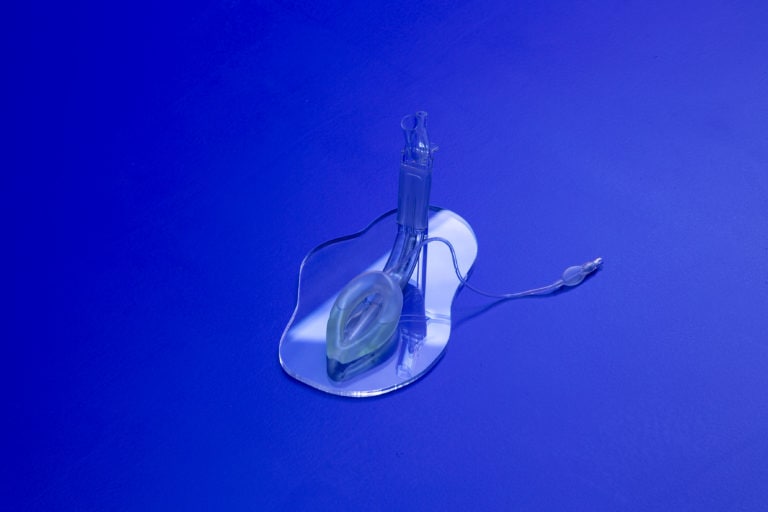
November 2022
WBH: The film titled Into The Violet Belly (2022), commissioned by the 12th Berlin Biennale, curated by Kader Attia, has been completed. Picking up from our earlier conversation, Han describes the centrality of breath and the act of breathing to the film.
THNC: Some years ago, I was in a car on the highway to Munich with my mother and her friend when an immense force moved my body forward and cloudy smoke emerged from within the car. Lying on the car floor, I was suffocating and desperately gasped for air. Later on, in the hospital, I learned that my lung was ruptured and bleeding. I experienced weeks of breathlessness following the car crash. I was dependent on an oxygen mask and a breathing exerciser until I regained full lung capacity. During this period, I spent most of my time practising and contemplating the act of breathing—the conditions that create the im/possibility to breathe. And I began to ask myself: How can I find ways to tune into the collective breath/lessness through my own individual breath/lessness, and vice versa?
This project was very much anchored in the notions of respiration and embodiment. During the film shooting, my mother and I performed the jump multiple times. First, she recalled her memories of the moments before the jump; her emotions, and the conditions that led to her decision to jump. Then she demonstrated the jump to me. When she emerged from the water and climbed back into the boat, I jumped into the water based on her instructions. She gave me directions on where to turn my gaze before the jump—to turn it toward an imaginary person—how to shift my body, how to step to the edge of the boat with one foot, and how to enter the water with my feet first. She emphasized that she didn’t jump headfirst into the water as she didn’t yet know how to swim. We performed—I consciously use the term “performance” and not “reenactment” here because I think that it is impossible to reenact the past—this jump again and again.
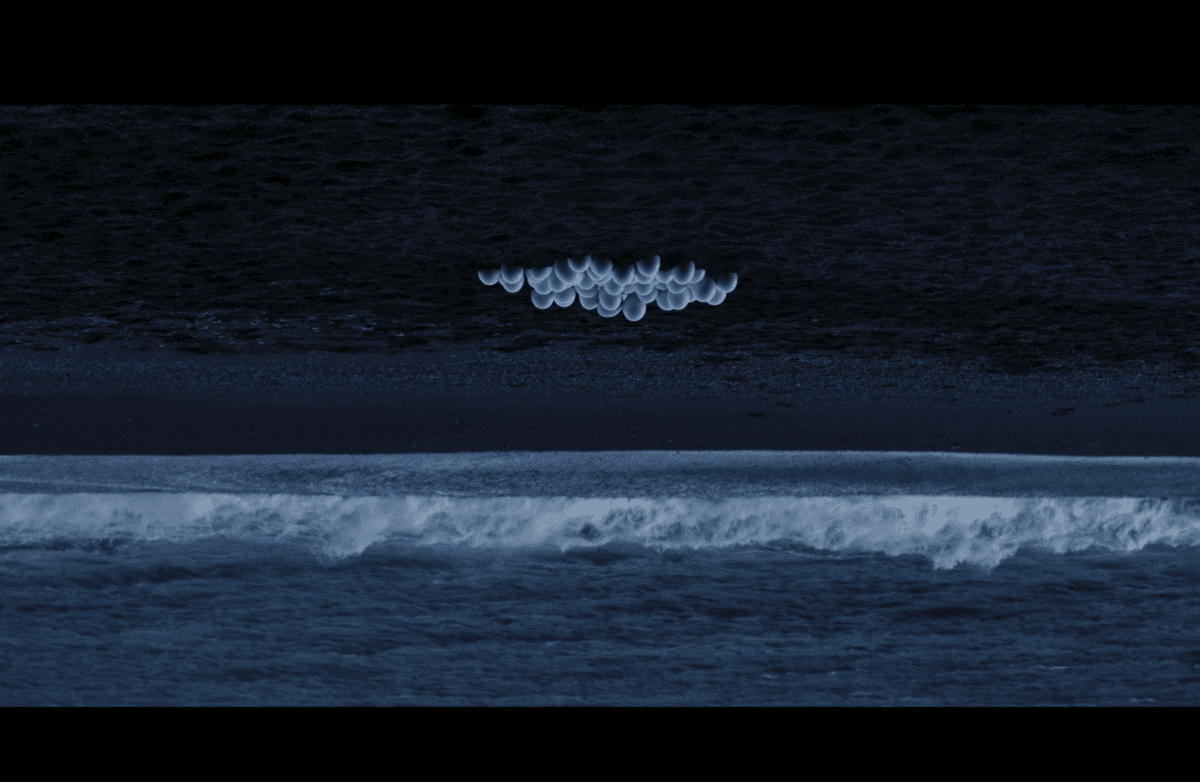
During the editing process, our editor Liyo Gong intercut footage of our jumping bodies into one synchronized movement, which was repeated seven times with variations. I wanted to interweave the movement of her body with the movement of my body—two bodies that have existed in an environment where it was difficult, if not impossible, to breathe; bodies that condense all the events that have happened, are happening, will happen—to the point where you can no longer clearly perceive the identities of these bodies, where you can no longer make a clear distinction between director and performer. My mother and I then watched this edited footage projected onto the screen in the post-production studio and reflected on what we saw, felt, thought. There is one sentence during these moments of reflection that she repeated in every variation of her story of being underwater that I left out in the final edit of Into The Violet Belly: “How was I able to open my eyes and see underwater like that? I was not suffocating at all. I felt like a marine mammal.” The fact that she could breathe underwater is surreal, somehow—
WBH: Miraculous.
THNC: Exactly. She always says it was “supernatural” that she could breathe underwater! And I imagine it as a moment where reality and fiction collapse into one another. Perhaps we can address these terms later—I’m digressing now, but do you know that whales evolved from a terrestrial ancestor and made a gradual transition from land to sea in the early Eocene?7Philip D. Gingerich, “Evolution of Whales from Land to Sea,” Proceedings of the American Philosophical Society 156, no. 3 (September 2012): 3, http://www.jstor.org/stable/23558092. During the first lockdown, I spent quite some time reading papers about the evolution of whales.8I’m referring to the following two papers: Philip D. Gingerich, “Land-to-Sea Transition in Early Whales: Evolution of Eocene Archaeoceti (Cetacea) in Relation to Skeletal Proportions and Locomotion of Living Semiaquatic Mammals,” Paleobiology 29, no. 3 (Summer 2003): 429–54, http://www.jstor.org/stable/4096936; and Gingerich, “Evolution of Whales from Land to Sea,” 309–23. It was mind-blowing to read about the major changes in multiple physiological functions required for them to move from being terrestrial to semiaquatic to fully aquatic. Whales continue to breathe air using lungs and nurse with mammary glands, as land mammals do.9Ibid. But the lung capacities of marine mammals are larger than terrestrial mammals, especially when compared on a lean-weight basis. When diving, marine mammals can supplement body oxygen stores by increasing the oxygen storage capacity of the lung, blood, and muscles.10G. L. Kooyman, “Respiratory Adaptations in Marine Mammals,” American Zoologist 13, no. 2 (May 1973): 457–68, http://www.jstor.org/stable/3882027.
So when writing the last scenes of the script and conjuring the images of this jump in my mind, I began to imagine a woman completely surrendering to death/life, to the ocean, putting aside her anthropoid ways,11Jue refers to an anecdote of Jacques Cousteau, an ocean explorer, who talks about “putting aside my anthropoid ways” and borrowing “the characteristics of a fish,” while diving and experimenting with breathing pure oxygen. See Melody Jue, Wild Blue Media: Thinking Through Seawater (Durham, NC: Duke University Press, 2020), 47. and gradually metamorphosing into a marine mammal12I am interested in Octavia E. Butler’s way of rewriting “the body in ways that disrupt historically ingrained patterns. They invoke the body not as mute, passive space that signifies the inferior part of our natures but as a place of vibrant connection, historical memory, and knowledge. By rewriting the body they also displace social Darwinist vertical hierarchies with horizontal relationships… Butler transforms her female protagonist into dolphins and leopards. Instead of peering down at other creatures, they look across, they look within, and—most importantly—away from. As the paths of humans and animals intersect, the body becomes a threshold, a site of elemental connections, and a space for “skin dreaming.” Greta Claire Gaard and Patrick D. Murphy, eds., Ecofeminist Literary Criticism: Theory, Interpretation, Pedagogy (Urbana: University of Illinois Press, 1998), 126. capable of seeing and “breathing”13Whales are air-breathing mammals. In order to breathe, they must raise their nostrils (also known as blowholes), which are placed at the highest part of the head, above the water. underwater. I imagine my mother encountering and turning into her human and more-than-human ancestors underwater. I imagine her migrating from land to sea within three days, three weeks, three months, three years, three decades, three centuries, three millennia, thirty thousand years, three hundred thousand years, three million years, thirty million years. I imagine millions of human and more-than-human beings migrating from land to sea to land at this very moment. I remember twenty-six-year-old Phạm Thị Trà My migrating from land to land to land, stuck in a truck with thirty-eight other young people when she sent a text message to her parents in the final moments of her life—a message that they received when her mobile phone found a signal again, long after all the occupants of the truck had taken their last breath: “Mom and Dad, I’m so sorry. I didn’t make it. Mom. I love you both. I’m dying because I can’t breathe. Mom, I’m so sorry.”14See Khuê Phạm und Vanessa Vu, “Pray for Me,” Zeit Online, posted May 17, 2020, https://www.zeit.de/gesellschaft/zeitgeschehen/2020-05/migration-vietnamese-dead-bodies-lorry-essex-grossbritannien-english?utm_referrer=https%3A%2F%2Fwww.google.com%2F. I imagine an environment where humans and more-than-human entities are given the possibility to expand their lung capacities and are liberated from the conditions that suffocate them. I imagine freedom of movement for all living beings, and the dissolution of borders between land and land, land and sea, sea and sea; of membranes between humans and humans, humans and more-than-humans; of the boundaries between where you begin and where I end. I imagine us speaking to each other, like whales speak to other whales, in a language of abstruse mathematical poetry.15Anthony D’Amato and Sudhir K. Chopra, “Whales: Their Emerging Right to Life,” American Journal of International Law 85, no. 1 (January 1991): 21–62, https://doi.org/10.2307/2203557. I imagine the collapse of sky and earth, of space and time, of self and self, and the evolution of beings, languages, images, and worlds we are incapable of imagining.
But whenever I look at the ocean, I think of all the corpses lying on the ocean bed, I become aware of the thousands, the millions of migrants at sea whose lungs were not prepared to breathe in an aquatic environment, whose voices are inaudible to us. When a human being drowns, “liquid enters their airways and prevents them from breathing. Submerged in water, one’s breath can be held voluntarily for some time, but without the ability to take in oxygen and to eliminate carbon dioxide, uncontrolled muscular contractions of the vocal folds ensue. One then experiences circulatory arrest, multiple organ dysfunction, and in the absence of rapid intervention and resuscitation, death.”16Maurice Stierl, “Can Migrants at Sea Be Heard?,” Discover Society, November 6, 2019, https://archive.discoversociety.org/2019/11/06/can-migrants-at-sea-be-heard/.
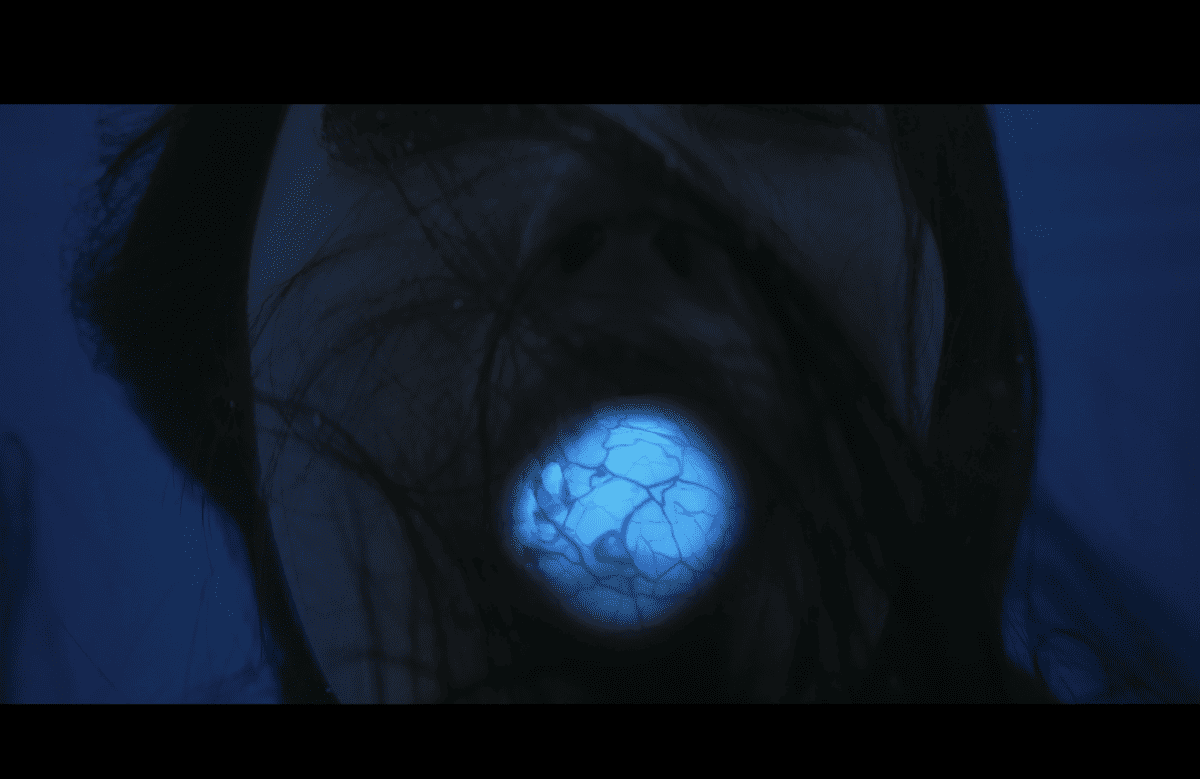
For the animation scene—the penultimate scene in my film, where we see a close-up of the protagonist’s face underwater—I worked with the artist Dalena Tran. Our point of departure was the image of a human lung transforming into a whale lung capable of breathing underwater. After having intense conversations with Dalena about our family’s histories and questions in relation to, but also beyond this project, over several months, she created an organism, a movement, a metamorphosis that is much more complex, open, multi-layered, and dimensional. It is amorphous. It embodies something I tentatively call an aesthetic of uncertainty.
Beyond thinking about breathing merely in its biological aspect, I’m also reminded of an essay by Achille Mbembe in which he conceives of breathing as that which “we all hold in common, that which, by definition, eludes all calculation”: the universal right to breathe17Achille Mbembe, “The Universal Right to Breathe,” trans. Carolyn Shread, Critical Inquiry 47, no. S2 (Winter 2021): 58–62, https://doi.org/10.1086/711437.—a right that has been violated by the conditions and forces of patriarchy, capitalism, imperialism, and colonialism. There is a paragraph in Frantz Fanon’s Black Skin, White Masks where he writes about the anti-French resistance during French colonialism in Vietnam: “It is not because the Indo-Chinese has discovered a culture of his own that he is in revolt. It is because ‘quite simply’ it was, in more than one way, becoming impossible for him to breathe… It is for the sake of the present and of the future that they are willing to die.”18Frantz Fanon, Black Skin, White Masks (1967; London: Pluto Press, 1986), 226–27. What could resistance mean in society, life, and art now? Can we find a commonness in how we breathe that would correspond to a commonness in that we breathe?19This is a reformulation of Fred Moten’s words in, “On Marjorie Perloff,” Entropy, https://entropymag.org/on-marjorie-perloff/. And within the context of filmmaking: How can I create a structure, a language, a rhythm that gives an image the possibility to breathe?
WBH: Two things stuck out to me. Firstly, that your work does not simply recount a biographical story through documentary. It’s not purely factual in that way. To go back to what you said earlier, you are interested in liberatory practices that, as I interpret it, involves an ongoing process of negotiation and aspiration instead of a finite outcome or indisputable narrative. The second thing that stood out to me was the word “reality,” in particular how your mother described as “surreal” the moment of miraculously being able to swim and breathe underwater despite never having learned to swim. Janet Mock succinctly writes that “‘realness’ means you are extraordinary in your embodiment of what society deems normative.”20Janet Mock, Redefining Realness: My Path to Womanhood, Identity, Love & So Much More (New York: Atria Books, 2014), 217. This applies of course to embodied transgender politics, but I’m also interested in what this then says about our sense of perception and scale, and the possibilities inherent in these codes of life. Reality is always embedded in surreality, which makes the latter even more magical and illusory. Was your mother actually able to see and breathe underwater, or was it a divine miracle? Maybe it was a bit of both.
THNC: Yes, absolutely. Reality and fiction interare.21Interpreting the Buddhist principle of interdependent co-arising in terms of interbeing—the idea that everything depends for its existence on everything else—Zen master Thích Nhất Hạnh coined the verb to interbe: “‘to be’ is to inter-be.” See Thich Nhat Hanh, Thich Nhat Hanh: Essential Writings (Maryknoll, NY: Orbis Book, 2001), 56. What I’ve attempted to do with this film is to create a structure, conditions, and methods for these realities/fictions to unfold, to converge and collide with each other. Thinking in dualistic terms, one may say that the film oscillates between various modes of reality/fiction: memory and imagination, documentary and (auto)fiction, mythology and science fiction, the process of filming and the film itself. I don’t know if I’ve succeeded in doing this, but my aspiration is to dissolve these distinctions, to make the viewer experience these different realities/fictions as rising and falling waves within a body of water.
I have a dear friend, a theoretical and experimental quantum physicist with whom I have talked about quantum physics and cinema on a regular basis. We have often contemplated the observer effect, a phenomenon in which the act of observation alters the reality you’re observing, i.e., the behavior of the particles being observed. It really fascinates me how ontology and epistemology are entangled within this context. While trying to avoid being simplistic and drawing direct parallels between these two drastically different fields, we have asked ourselves how the presence of a camera shapes the realities/fictions we’re observing through the lens. How will being conscious of the fact that our dialogue, our (inter)action will be recorded with a camera and observed by an audience shape the way my mother and I talk to and interact with each other? Being conscious of the fact that this exchange between you and me will be published and observed by a reader—how does that shape the way we conduct and edit the conversation? Does our (inter)action become a form of performance? Does this performance make visible a certain reality/fiction? What kind of reality/fiction do we observe when we’re filming the protagonist before we say “action” and keep filming after we say “cut”?
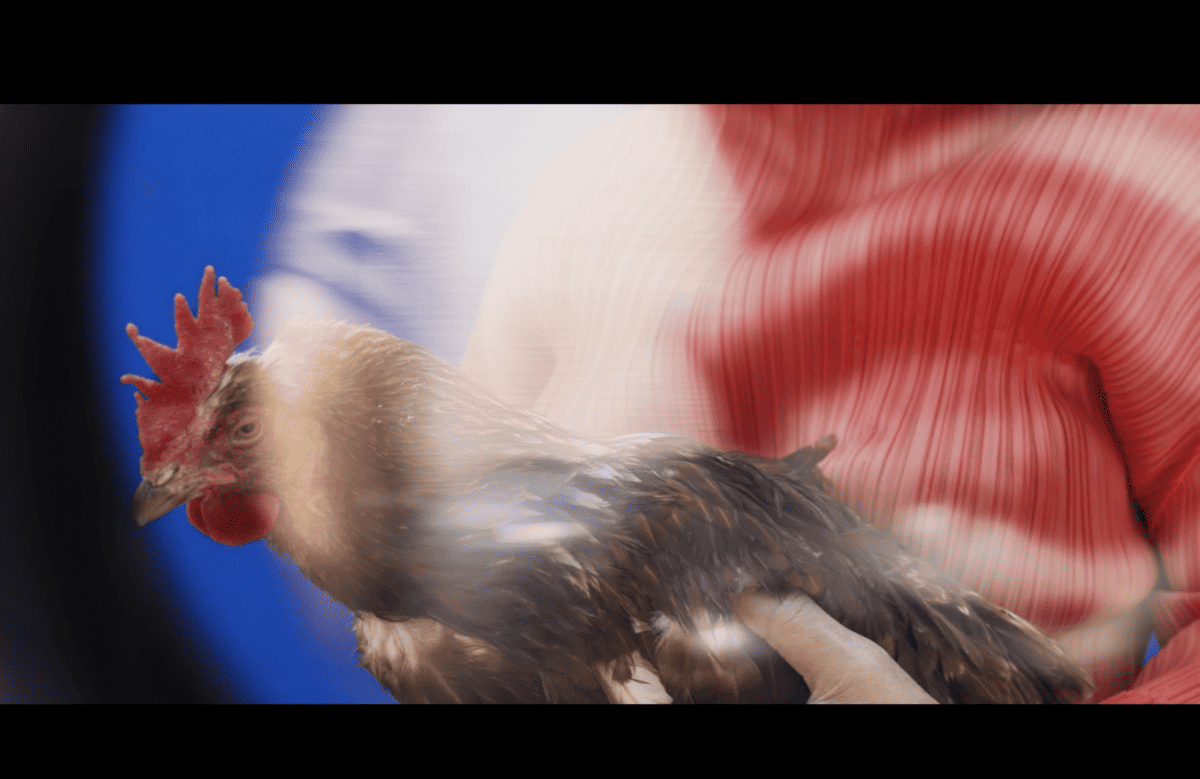
There is a scene in the film where you can hear the protagonist talking to the chicken she’s holding in her arms, while the cinematographer changes the lens. You can see how the image changes after the new lens has been installed. The director then asks the protagonist to wait for a few seconds before the actual scene begins, before they dive into a mnemonic space. Gradually, it becomes clear that the protagonist is a mother telling the story to her child. Toward the end of the scene, she says, “In challenging times, you have to be a good actor. The better you are, the more likely you are to get yourself out of dangerous situations.” The moment she says that, something strange, perhaps even surreal happens. This scene is probably a condensation of some of the ideas and questions I previously addressed.
Finally, although the film takes my mother’s individual experience as a point of departure, I hope to expand that experience and create a cinematic ecosystem by layering multiple oral and written (non)narratives, realities and fictions, events and agencies shaped by both human and more-than-human forces across space and time.
WBH: Another word that came to mind is performance. With regards to the performance of motherhood in your work, I thought specifically of how Joshua Chambers-Letson describes performance as “a way to reproduce our losses in the present and defer the second killing of our loved ones.”22Joshua Chambers-Letson, “Performance’s mode of reproduction I: searching for Danh Võ’s mother,” Women & Performance: a journal of feminist theory 26, nos. 2–3 (2016): 134: “Performance is the means through which the traces of life conferred to ephemera can be reanimated; it is the method through which we reproduce our losses in the present.” Writing about Danh Vo’s 2012 exhibition I M U U R 2, an extensive and curated display of almost four thousand objects collected by the late artist Martin Wong and his mother, Florence Wong Fie, Chambers-Letson further argues that through “performance’s quite queer mode of reproduction . . . queer of color life is reproduced by an aesthetic gesture, rather than biological process,” suggesting that “a mother need not be of biological relationship to the child to be a mother, nor must her status as mother be determined by her, his, or their biology.”23Joshua Chambers-Letson, After the Party: A Manifesto for Queer of Color Life (New York: NYU Press, 2018), 114–22.
As you were talking about quantum physics, I also thought of an essay by Karen Barad, in which she writes, “It is not that electrons sometimes engage in such perverse explorations: these experiments in intra-active trans*material performativity are what an electron is. . . . Ontological indeterminacy, a radical openness, an infinity of possibilities, is at the core of mattering. . . . Matter is never a settled matter. It is always already radically open.”24Karen Barad, “Transmaterialities: Trans*/Matter/Realities and Queer Political Imaginings,” GLQ: A Journal of Lesbian and Gay Studies 21, nos. 2–3 (June 2015): 401.
I thought this could also be a good point to talk about how your work embodies the radical openness of matter. At some point in our conversations, we realized that we each have a very representative color. Yours is blue and mine is pink. You once described color as not just a superficial aesthetic choice. It is a core conceptual and theoretical point of our research and practice. Pink is something that I can’t fully rationalize. It has been with me since I was a teenager. When we pointed out blue and pink as each other’s go-to colors, it got me thinking about how they are loaded with cultural ideologies, the most obvious being sex and gender norms. In his book Chromophobia, the artist David Batchelor argues that “colour has been the object of extreme prejudice in Western culture,” and that these presumably skin-deep, cosmetic prejudices are in fact codes for deeply entrenched fears and anxieties, for example, of contamination and corruption by unknown, foreign entities including migrants, the queer, the feminine, the Oriental, and so on.25David Batchelor, Chromophobia (London: Reaktion: 2000), 22–23. For Batchelor, the prejudice against color “conflate[s] the sinister and the superficial.”26Ibid., 23. Funnily, Batchelor, when referencing philosopher C. L. Hardin’s extensive studies on the science of color, mentions, almost as an afterthought in parentheses, that “the entire existence of pink” is an “anomaly.”27Ibid.,, 91. I love that there is no disguising the iconic irrelevance of pink. As a non-binary person, I think my work is so defined by lurid, blooming pinks because it hints at the gendered experiences and expectations that I’ve been excluded from but that have, and remain, palpable to me in different ways. Pink is my negotiation with worldly impositions. Could you talk more about how the color blue performs or does the work of imagination in your practice?
THNC: That was amazing. I love the interconnections you’re creating. Have you, as a child, also asked yourself why the sky is blue? There is a paragraph in Maggie Nelson’s Bluets I really like: “The blue of the sky depends on the darkness of empty space behind it. As one optics journal put it, ‘The color of any planetary atmosphere viewed against the black of space and illuminated by a sunlike star will also be blue.’ In which case blue is something of an ecstatic accident produced by void and fire.” Produced by darkness and light, void and fire, wow!
One of my favourite films is Derek Jarman’s Blue. It’s a meditation on his experience with AIDS, color, and the void through an intricately layered landscape of voices, sounds, and music set against an unchanging field of blue.28Derek Jarman references Yves Klein’s evocation of the void through the use of International Klein Blue. Jarman states in a proposal for the film, “The monochrome is an alchemy, effective liberation from personality. It articulates silence. It is a fragment of an immense work without limit. The blue of the landscape of liberty.”29Tony Peake, Derek Jarman: A Biography (Woodstock, NY: Overlook Press, 2000), 515. Although liberty may hold different meanings in our works, I, too, aspire to move into a “landscape of liberty” at the end of Into The Violet Belly.
For the last scene, I collaborated with Frankie (Franziska Aigner) who composed, produced, and performed a song based on “Learning Late Letters,” a poem written by Quyên Nguyễn-Hoàng.30“Learning Late Letters” by Quyên Nguyễn-Hoàng was published in Poem-a-Day in partnership with Words Without Borders on September 12, 2020, by the Academy of American Poets, https://poets.org/poem/learning-late-letters. Frankie reduced the second part of the song—in which she recites various forms of dying—to two elements: the sound of my mother’s breath and her own voice. I was deeply moved by her process of recording my mother’s breathing. Fujiko Nakaya speaks about the interval between an inbreath and an outbreath as an “empty void” that contains the “largest potential.”31Fujiko Nakaya, “New Media Age in Japan,” Video Guide 33, no. 3 (May 1985): 10, http://archive.vivomediaarts.com/wp-content/uploads/2020/05/VGUIDESno031small.pdf. In the last moments of the film, all images die: the viewer is invited to become “an astronaut of the void”32Steven Dillon, Derek Jarman and Lyric Film: The Mirror and the Sea (Austin: University of Texas Press, 2004), 235. by immersing themselves in a field of blue—perhaps an interval between life and death—while listening to my mother’s breaths and Frankie’s voice.
But like your relationship with pink, I can’t fully rationalize mine with blue. So let me tentatively close this conversation by saying: She who jumps into the void owes no explanation to those who stand and watch.33Modified quote by Jean-Luc Godard. Found as an epigraph at the opening of Brad Evans, Ecce Humanitas: Beholding the Pain of Humanity (New York: Columbia University Press, 2021).
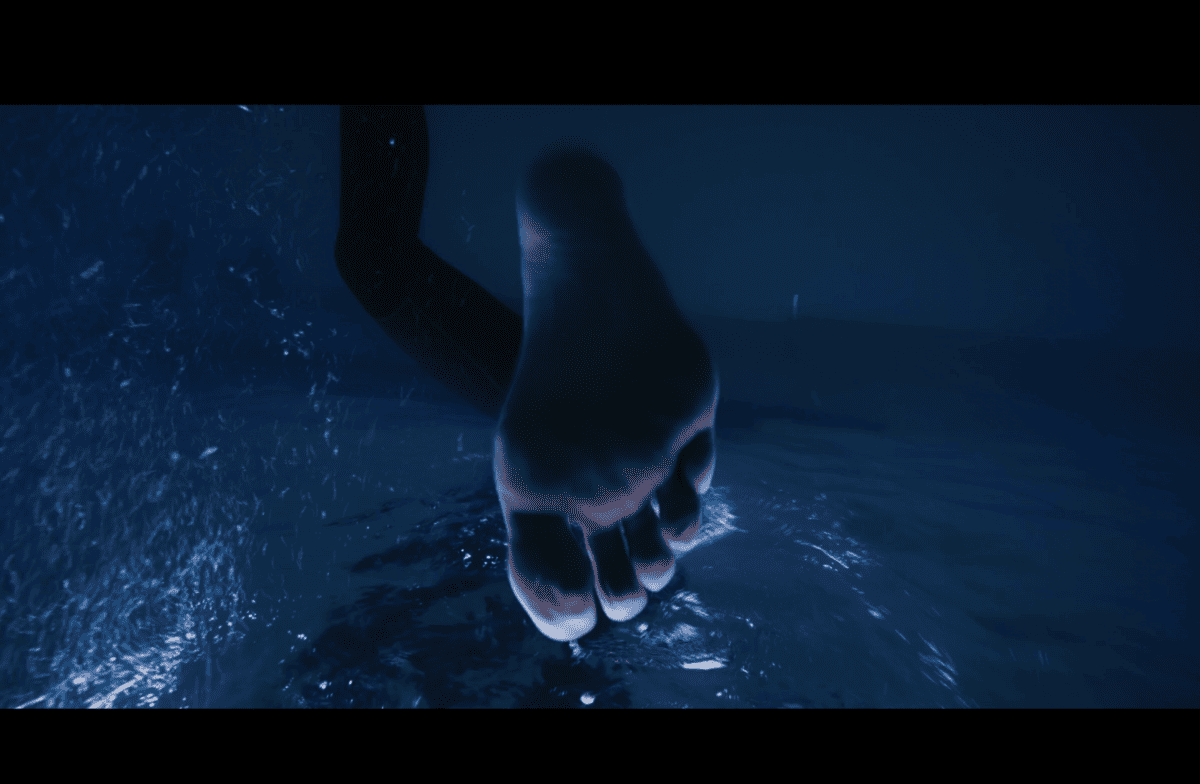
- 1Describing the premise of a global power perceiving its self-interest secured by granting to another the gift of freedom, Mimi Thi Nguyen asks the following: “How then do we parse the seeming paradox in which U.S. military interventions are described through beneficence and defense, and at the same time demand occupations and dislocations of racial, colonial others in the name of the human, through invocations of peace, protection, rights, democracy, freedom, and security?… What then does it mean for a racial, colonial other to ‘finally’ possess freedom? How can it be that the possibility of ‘owning’ freedom is worth everything and nothing?” See Mimi Thi Nguyen, The Gift of Freedom: War, Debt, and Other Refugee Passages (Durham, NC: Duke University Press, 2012), xii, 17–18.
- 2“Refugitude” is a term advanced by Khatharya Um: “Whereas the term ‘refugee’ has been made synonymous with needs, refugitude rescues it from reductionist pejorative connotations with equal attention to hope and futurity. It replaces reductionism with attention to complexity of refugee lives, and binaries with juxtapositions and interstices as dynamic sites of negotiation and creation.” “Critical Vocabularies,” Critical Refugee Studies, https://criticalrefugeestudies.com/resources/critical-vocabularies.
- 3Hélène Cixous, “We Who Are Free, Are We Free?,” trans. Chris Miller, Critical Inquiry 19, no. 2 (Winter 1993): 201–19, http://www.jstor.org/stable/1343873.
- 4Hélène Cixous’s original question is “What am I in relation to liberty?” Ibid., 202.
- 5Ibid., 201–19.
- 6Angela Davis, “Angela Davis and Toni Morrison Literacy, Libraries and Liberation,” posted by Daryl Banks, April 21, 2022, YouTube video, 1:44:59, https://www.youtube.com/watch?v=zLR_TcGHzRU.
- 7Philip D. Gingerich, “Evolution of Whales from Land to Sea,” Proceedings of the American Philosophical Society 156, no. 3 (September 2012): 3, http://www.jstor.org/stable/23558092.
- 8I’m referring to the following two papers: Philip D. Gingerich, “Land-to-Sea Transition in Early Whales: Evolution of Eocene Archaeoceti (Cetacea) in Relation to Skeletal Proportions and Locomotion of Living Semiaquatic Mammals,” Paleobiology 29, no. 3 (Summer 2003): 429–54, http://www.jstor.org/stable/4096936; and Gingerich, “Evolution of Whales from Land to Sea,” 309–23.
- 9Ibid.
- 10G. L. Kooyman, “Respiratory Adaptations in Marine Mammals,” American Zoologist 13, no. 2 (May 1973): 457–68, http://www.jstor.org/stable/3882027.
- 11Jue refers to an anecdote of Jacques Cousteau, an ocean explorer, who talks about “putting aside my anthropoid ways” and borrowing “the characteristics of a fish,” while diving and experimenting with breathing pure oxygen. See Melody Jue, Wild Blue Media: Thinking Through Seawater (Durham, NC: Duke University Press, 2020), 47.
- 12I am interested in Octavia E. Butler’s way of rewriting “the body in ways that disrupt historically ingrained patterns. They invoke the body not as mute, passive space that signifies the inferior part of our natures but as a place of vibrant connection, historical memory, and knowledge. By rewriting the body they also displace social Darwinist vertical hierarchies with horizontal relationships… Butler transforms her female protagonist into dolphins and leopards. Instead of peering down at other creatures, they look across, they look within, and—most importantly—away from. As the paths of humans and animals intersect, the body becomes a threshold, a site of elemental connections, and a space for “skin dreaming.” Greta Claire Gaard and Patrick D. Murphy, eds., Ecofeminist Literary Criticism: Theory, Interpretation, Pedagogy (Urbana: University of Illinois Press, 1998), 126.
- 13Whales are air-breathing mammals. In order to breathe, they must raise their nostrils (also known as blowholes), which are placed at the highest part of the head, above the water.
- 14See Khuê Phạm und Vanessa Vu, “Pray for Me,” Zeit Online, posted May 17, 2020, https://www.zeit.de/gesellschaft/zeitgeschehen/2020-05/migration-vietnamese-dead-bodies-lorry-essex-grossbritannien-english?utm_referrer=https%3A%2F%2Fwww.google.com%2F.
- 15Anthony D’Amato and Sudhir K. Chopra, “Whales: Their Emerging Right to Life,” American Journal of International Law 85, no. 1 (January 1991): 21–62, https://doi.org/10.2307/2203557.
- 16Maurice Stierl, “Can Migrants at Sea Be Heard?,” Discover Society, November 6, 2019, https://archive.discoversociety.org/2019/11/06/can-migrants-at-sea-be-heard/.
- 17Achille Mbembe, “The Universal Right to Breathe,” trans. Carolyn Shread, Critical Inquiry 47, no. S2 (Winter 2021): 58–62, https://doi.org/10.1086/711437.
- 18Frantz Fanon, Black Skin, White Masks (1967; London: Pluto Press, 1986), 226–27.
- 19This is a reformulation of Fred Moten’s words in, “On Marjorie Perloff,” Entropy, https://entropymag.org/on-marjorie-perloff/.
- 20Janet Mock, Redefining Realness: My Path to Womanhood, Identity, Love & So Much More (New York: Atria Books, 2014), 217.
- 21Interpreting the Buddhist principle of interdependent co-arising in terms of interbeing—the idea that everything depends for its existence on everything else—Zen master Thích Nhất Hạnh coined the verb to interbe: “‘to be’ is to inter-be.” See Thich Nhat Hanh, Thich Nhat Hanh: Essential Writings (Maryknoll, NY: Orbis Book, 2001), 56.
- 22Joshua Chambers-Letson, “Performance’s mode of reproduction I: searching for Danh Võ’s mother,” Women & Performance: a journal of feminist theory 26, nos. 2–3 (2016): 134: “Performance is the means through which the traces of life conferred to ephemera can be reanimated; it is the method through which we reproduce our losses in the present.”
- 23Joshua Chambers-Letson, After the Party: A Manifesto for Queer of Color Life (New York: NYU Press, 2018), 114–22.
- 24Karen Barad, “Transmaterialities: Trans*/Matter/Realities and Queer Political Imaginings,” GLQ: A Journal of Lesbian and Gay Studies 21, nos. 2–3 (June 2015): 401.
- 25David Batchelor, Chromophobia (London: Reaktion: 2000), 22–23.
- 26Ibid., 23.
- 27Ibid.,, 91.
- 28Derek Jarman references Yves Klein’s evocation of the void through the use of International Klein Blue.
- 29Tony Peake, Derek Jarman: A Biography (Woodstock, NY: Overlook Press, 2000), 515.
- 30“Learning Late Letters” by Quyên Nguyễn-Hoàng was published in Poem-a-Day in partnership with Words Without Borders on September 12, 2020, by the Academy of American Poets, https://poets.org/poem/learning-late-letters.
- 31Fujiko Nakaya, “New Media Age in Japan,” Video Guide 33, no. 3 (May 1985): 10, http://archive.vivomediaarts.com/wp-content/uploads/2020/05/VGUIDESno031small.pdf.
- 32Steven Dillon, Derek Jarman and Lyric Film: The Mirror and the Sea (Austin: University of Texas Press, 2004), 235.
- 33Modified quote by Jean-Luc Godard. Found as an epigraph at the opening of Brad Evans, Ecce Humanitas: Beholding the Pain of Humanity (New York: Columbia University Press, 2021).
